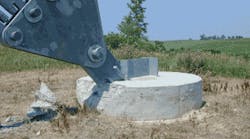Many Americans still rely on the radio and television for news and entertainment. In particular, radio and television broadcasts are important to the residents of the rural, agricultural communities nestled between Iowa, South Dakota, and Nebraska. This area of mostly prairie and farmland, roughly centered in Sioux City, Iowa, is served by KPTH and KMEG as well as their network-affiliated television stations. Broadcasting from a single tower in Hinton, Iowa, these two stations have been providing important news and information to the people of the surrounding area for more than 44 years.
The 1,988-ft tower is among the 50 tallest guyed towers in the United States. Reaching more than three-eighths of a mile high and surrounded by flat, rolling plains, the tower is especially susceptible to severe lightning strikes. According to the National Weather Service, this area receives more than 50 thunderstorms annually, on average, making the tower a prime target for lightning damage. In the past, two particularly intense lightning strikes could have destroyed the broadcast tower completely.
The first strike caused minor structural damage. The second, however, delivered a much more concentrated blow, causing severe damage to two of the massive reinforced-concrete anchors, which secured the cables keeping the tower upright. The anchors extend between 40ft and 52 ft underground. Concerns over the tower collapsing, which would take the station off the air for several months while it was being repaired, led to an upgrade of the entire facility's grounding and lightning protection system.
When evaluating the lightning damage, the grounding system was among the first components to be questioned. For answers, the owners turned to Computer Power & Consulting Corporation, an Omaha, Neb.-based company with more than 30 years of experience with lightning protection, grounding, and power quality issues. Martin Conroy, the company’s founder and president, was not surprised at what he discovered.
“Based on the location and nature of the damage, along with what we saw in the tower’s construction plans and what we found in the field, we strongly suspected that the culprit here was an inadequate grounding system,” says Conroy.
As part of the solution, Conroy added three 80-ft-deep vertical earth electrodes at the tower, interconnected by a 250-kcmil tinned-copper ring ground, and then ran three 250-kcmil radials from the ring to the tower base. All cable connections were made with tinned, solid-copper mechanical connectors. According to Dave Brender, national program manager for the Copper Development Association, use of copper in this installation provided excellent electrical conductivity and resistance to corrosion and played an integral part in lightning protection.
Since the new system was installed, Gina Dierks, broadcast IT engineer for the two stations, says the facility hasn't had any problems with lightning damage. "We certainly haven’t been taken off the air, which means none of us has had to go to the tower in the middle of the night," she says. "That’s always a good thing!”



